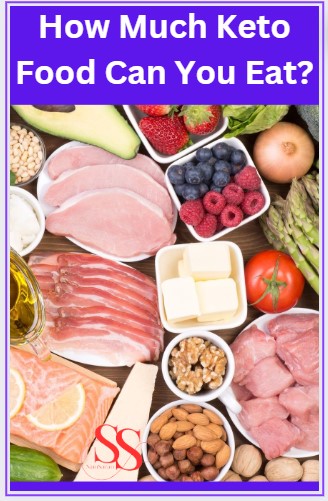When embarking on a ketogenic diet, understanding how much food you can consume is essential for success. Portion control plays a crucial role in maintaining ketosis and achieving your health goals. By managing your food intake effectively, you can optimize your body’s fat-burning capabilities and experience the numerous benefits of the keto lifestyle. In this article, you will get to know how much Keto food can you eat.
How Much Keto Food Can You Eat?
On the keto diet, it’s vital to track your macronutrient intake to ensure you’re consuming the right proportions of fats, proteins, and carbohydrates. Monitoring your macros not only helps you stay within your daily limits but also enables you to adjust your intake based on your unique nutritional needs and weight loss goals.

Calculating Your Ideal Food Portions
To determine how much keto food you can eat, you can use online calculators or consult with a nutritionist to create a customized meal plan. These tools consider factors such as your age, weight, activity level, and metabolic rate to provide you with personalized portion recommendations. By following these guidelines, you can maintain ketosis while enjoying delicious and satisfying meals.
Listening to Your Body’s Hunger Cues
While tracking macros is essential on the keto diet, listening to your body’s hunger cues is equally important. Pay attention to feelings of hunger and fullness to avoid overeating and ensure you’re nourishing your body appropriately. By eating mindfully and savoring each bite, you can maintain a healthy relationship with food and support your overall well-being.
Experimenting with Meal Timing and Frequency
In addition to monitoring your portion sizes, experimenting with meal timing and frequency can help you determine the optimal eating schedule for your body. Some individuals thrive on three square meals a day, while others prefer smaller, more frequent meals. By exploring different approaches, you can find the eating pattern that works best for you and supports your energy levels and satiety.
Finding the right balance of keto food intake is a key component of achieving success on the ketogenic diet. By understanding portion control, tracking your macros, listening to your body, and experimenting with meal timing, you can optimize your nutritional intake and experience the full benefits of the keto lifestyle. Remember that everyone’s dietary needs are unique, so it’s essential to find a routine that works best for your body and supports your health and weight loss goals.
The Power of Keto Food Consumption
Keto diet, short for ketogenic diet, is a high-fat, low-carb eating plan that has gained popularity for its potential health benefits. By drastically reducing carbohydrate intake and replacing it with fats, the body enters a state of ketosis, where it uses fat for energy instead of carbohydrates.
The Importance of Proper Food Consumption on Keto
When following a keto diet, the quality of food consumed plays a crucial role in achieving and maintaining ketosis. Opt for whole, nutrient-dense foods such as avocados, olive oil, nuts, seeds, and fatty fish to ensure a well-rounded intake of essential nutrients while keeping carb levels low.
Key Foods to Include in Your Keto Diet
Avocados
Avocados are a staple in the keto diet due to their high healthy fat content and low carbs. They are versatile and can be enjoyed in various dishes, from salads to smoothies.
Coconut Oil
Coconut oil is rich in medium-chain triglycerides (MCTs), which are easily converted into ketones by the liver, supporting ketosis. Use it for cooking or add it to your morning coffee for an energy boost.
Leafy Greens
Leafy greens like spinach, kale, and Swiss chard are low in carbs and high in fiber and essential nutrients. They can be incorporated into salads, omelets, or smoothies.
Berries
While most fruits are high in carbs, berries such as strawberries, blueberries, and raspberries are lower in carbs and can be enjoyed in moderation on a keto diet.
The Pitfalls to Avoid in Keto Food Consumption
Hidden Sugars
Be wary of hidden sugars in processed foods, condiments, and sauces, as they can quickly add up and kick you out of ketosis.
Overconsumption of Protein
Consuming excess protein on a keto diet can also hinder ketosis, as excess protein can be converted into glucose through a process called gluconeogenesis.
Embracing a Sustainable Keto Lifestyle
By prioritizing whole, nutrient-dense foods and being mindful of hidden sugars and protein intake, you can harness the power of keto food consumption for improved energy levels, weight management, and overall well-being. Remember, consistency is key in reaping the benefits of the keto diet.
In conclusion, mastering the art of keto food consumption involves making informed choices that align with the principles of the ketogenic diet. By focusing on high-quality fats, moderate protein, and low-carb vegetables, you can embark on a flavorful and fulfilling keto journey that supports your health and wellness goals.
Leave a Reply